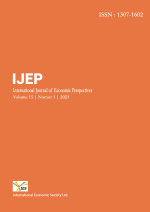Economic impact of tourism in Rishikesh Town Uttarakhand
Keywords:
ambiance, challenges, development, economy, practicableAbstract
Rishikesh is internationally recognized as one of the best place for tourism due to yoga and Ayurveda facility, spiritual ambiance and best adventure spot in India. This town is faced many challenges to the economic development. Tourism is seen as in practicable and sometimes only means of economic growth not focusing on the economic development in the town. The present research deals with an impact of tourism on the economy of this town. The paper is in descriptive in nature, and it shows that tourism has made adequate contribution to the local economy in Rishikesh town.
References
Cooper, A. C. (1993). Challenges in predicting new firm performance. Journal of business venturing, 8(3), 241-253. https://doi.org/10.1016/0883-9026(93)90030-9
Dale, V. H., & Beyeler, S. C. (2001). Challenges in the development and use of ecological indicators. Ecological indicators, 1(1), 3-10. https://doi.org/10.1016/S1470-160X(01)00003-6
Florence, I. K., & Anthony, K. A. (2016). Employee relationship management and employee performance: reward in focus. International Journal of Economic Perspectives, 10(1), 24–44. Retrieved from https://ijeponline.org/index.php/journal/article/view/33
Gill, N., & Singh, R. P. (2013). Socio-economic impact assessment of tourism in Pithoragarh district, Uttarakhand. International journal of advancement in remote sensing, GIS and geography, 1(1), 1-7.
Graave, E. J., Klijs, J., & Heijman, W. (2017). The economic impact of pilgrimage: an economic impact analysis of pilgrimage expenditures in Galicia. International Journal of Religious Tourism and Pilgrimage, 5(3), 39-54.
Granger, C. W. (1988). Some recent development in a concept of causality. Journal of econometrics, 39(1-2), 199-211. https://doi.org/10.1016/0304-4076(88)90045-0
KM, A. K. (2015). Socio-Economic and Environmental Impact of Tourism in Kodagu District (India): A Case Study. Universal Journal of Environmental Research & Technology, 5(1).
Korhonen, J., Honkasalo, A., & Seppälä, J. (2018). Circular economy: the concept and its limitations. Ecological economics, 143, 37-46. https://doi.org/10.1016/j.ecolecon.2017.06.041
Malterud, K. (2001). Qualitative research: standards, challenges, and guidelines. The lancet, 358(9280), 483-488. https://doi.org/10.1016/S0140-6736(01)05627-6
Mishra, D., Mishra, A., & Ostrovska, S. (2012). Impact of physical ambiance on communication, collaboration and coordination in agile software development: An empirical evaluation. Information and software Technology, 54(10), 1067-1078. https://doi.org/10.1016/j.infsof.2012.04.002
Moraga, G., Huysveld, S., Mathieux, F., Blengini, G. A., Alaerts, L., Van Acker, K., ... & Dewulf, J. (2019). Circular economy indicators: What do they measure?. Resources, Conservation and Recycling, 146, 452-461. https://doi.org/10.1016/j.resconrec.2019.03.045
Naz, H., & Ahmad, E. (2021). Development of school adjustment scale. International Journal of Economic Perspectives, 15(1), 122–127. Retrieved from https://ijeponline.org/index.php/journal/article/view/29
Oakes, J. M. (2004). The (mis) estimation of neighborhood effects: causal inference for a practicable social epidemiology. Social science & medicine, 58(10), 1929-1952. https://doi.org/10.1016/j.socscimed.2003.08.004
Pratt, S. (2015). The economic impact of tourism in SIDS. Annals of tourism research, 52, 148-160.
Sadler, P. G., & Archer, B. H. (1975). The economic impact of tourism in developing countries. Annals of tourism research, 3(1), 15-32.
Toya, H., & Skidmore, M. (2007). Economic development and the impacts of natural disasters. Economics letters, 94(1), 20-25. https://doi.org/10.1016/j.econlet.2006.06.020
Vogel, L., & Peukert, W. (2004). Determination of material properties relevant to grinding by practicable labscale milling tests. International Journal of Mineral Processing, 74, S329-S338. https://doi.org/10.1016/j.minpro.2004.07.018
Published
How to Cite
Issue
Section
Copyright (c) 2021 Rashmi

This work is licensed under a Creative Commons Attribution 4.0 International License.
Allows users to: distribute and copy the article; create extracts, abstracts, and other revised versions, adaptations or derivative works of or from an article (such as a translation); include in a collective work (such as an anthology); and text or data mine the article. These uses are permitted even for commercial purposes, provided the user: gives appropriate credit to the author(s) (with a link to the formal publication through the relevant URL ID); includes a link to the license; indicates if changes were made; and does not represent the author(s) as endorsing the adaptation of the article or modify the article in such a way as to damage the authors' honor or reputation. CC BY







